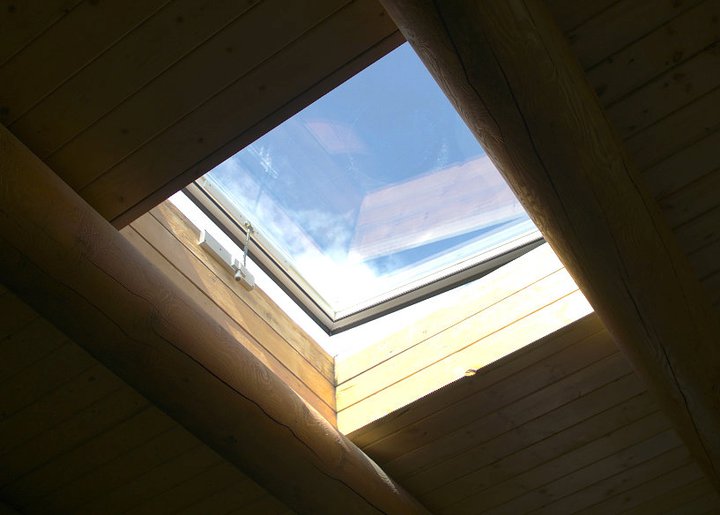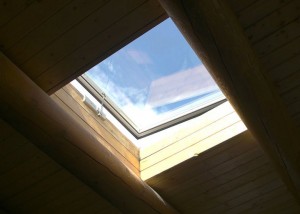
I have not posted about earthship construction since we installed the flashing along the south edge of the roof … we have been doing some work since then.
Our goal this spring (it has now officially been summer for a couple of weeks) was to finish some of the roofing details that we did not get around to last summer; this included flashing along the south edge of the roof (and along the sides of the kicked up portion of the roof), installing skylights and finishing the roof over the south door.
We flashed the south edge of the roof back in June, and we also flashed along one side of the kicked up portion of the roof a few weeks ago. Flashing along the edge of the kicked up roof was virtually identical to flashing the south edge of the roof except that we also had to account for the change of pitch in the roof at the junction of the greenhouse roof and the main roof. We solved this issue by cutting and bending the flashing. Our solution along the side works but we expect it will change; we want to put a small roof over each side door to protect them from the weather so we will have to accommodate these roofs at a later date.
With the roof flashing well in hand we also turned our attention to the skylights last month. We built our skylight boxes (or wells as they seem to be referred to commercially) as specified in Earthship Volume I. We built 4’x4′ boxes out of 2″ dimensional lumber that we centred on the rafters where we wanted them in each room. This worked well and we simply finished around these boxes as we were insulating and installing the roof membrane.
We initially planned to build our own skylights as is described in the Earthship volumes, but eventually decided in favour of commercial units. We did not pay attention when picking our skylight locations in each room … the Earthship Volumes suggest placing the skylights as far back north in each room as is possible. The north location ensures better ventilation and means that you are close to a wall. The skylights described in the Earthship volumes use cantilevered weights and a cleated rope that dangles down from the skylight for opening and closing. By placing the skylight as far north as possible you ensure that the dangling rope is close to a wall where a cleat can be installed and the rope can be tied off out of the way. Due to our skylight placements in some rooms the rope would be dangling down without a convenient wall to cleat to … not a good finishing detail. Much more importantly I was not comfortable that I could build a unit that lasted a long time, was worried about leaks and at the end of the day was not convinced I would save much money by building my own operable skylight once I had purchased all of the components.
I found out fairly quickly while shopping for skylights that the industry standard for a 4’x4′ skylight well is to build it 4′ on centre (which makes a lot of sense as framing lumber is typically 16″ or 24″ on centre) … as opposed to the 4′ (outside edge to outside edge) that I had built. This meant that we had to modify the tops of our skylight boxes by attaching a 2 – 1/2″ x 2 – 1/4″ wooden adapter plate to the tops of our wells so that the skylights we purchased would fit. Building this adapter turned out to be more tedious than complicated; the flashing at the top of the skylight well had to be cut away, the adapter ring installed and then the top of the well and the adapter had to be re-flashed.
We purchased our skylights from Dayliter Skylights in Langley, BC. We saved on freight as we (or relatives) frequently pass by Langley. These units have a double layer of safety glass and an acrylic dome on top. Once we fixed our wells installation was very simple, and I am pretty confident I could not have built a unit of comparable quality. Each unit was approximately $600.00.
We installed our first skylight on Saturday (thanks James) and finished our second one today. It is amazing how much more light there is in these rooms! I noticed this evening when we went out to finish the second skylight that it was brighter in the back of the earthship than it was in our current dwelling at the same time in the evening … passive lighting really does work!
James took a lot of pictures of the first skylight we installed and I hope he posts them soon! Hopefully we will install the remaining three skylights this coming week …

Hello Sandra & Chris,
You have a beautiful website with subtle & calm colors, easy fonts on the eyes! It’s so full of interesting information! What an amazing home you have created!!! I would love to see it some time in the future when you are planning a tour.
Best wishes,
Anne Sperling